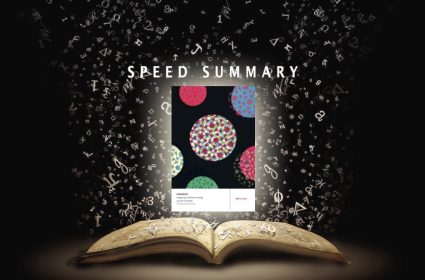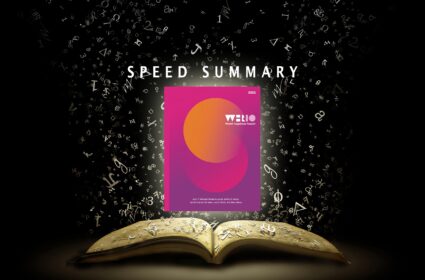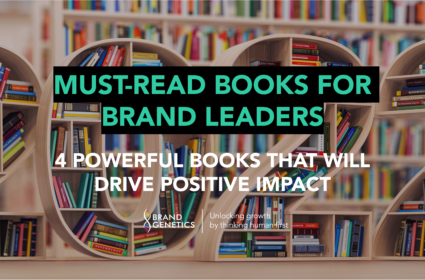Pre-suasion (Speed Summary)
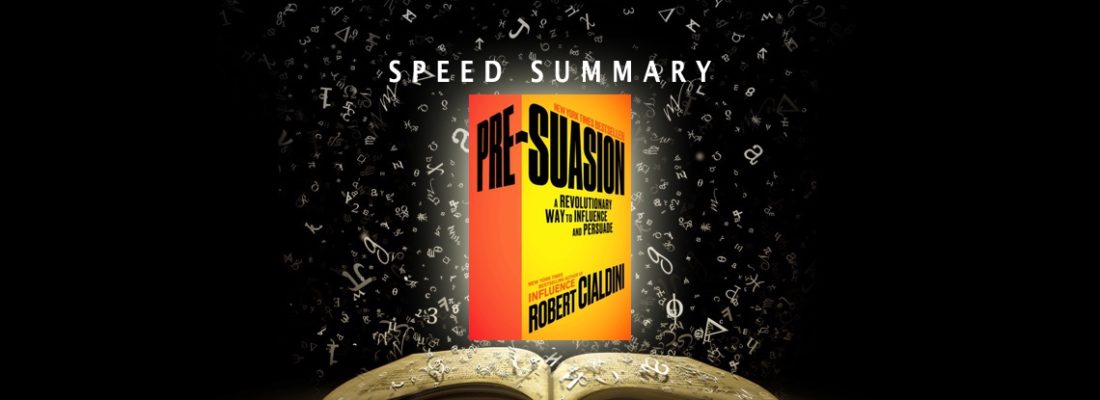

- Pre-suasion: A Revolutionary Way to Influence and Persuade
- Author: Robert Cialdini
- Publisher: Random House Books
- Publication: 2016
The most valuable commodity of the 21st century is attention.
Although attributed to investor and philanthropist Esther Dyson, this insight is subject of Robert Cialdini’s new book Pre-suasion. ‘Pre-suasion’ is the art of influence by capturing and channeling attention. Rather than seek to change what people think (difficult), change what they think about instead by directing their attention (easy). The changed focus of our attention primes, anchors, frames and sets the agenda for our subseqeunt choices. Smart influence happens before any message is sent.
Pre-suasion may be controversial for traditional communicators – it argues that influence is primarily a game of attention and association, not persuasion and argument. But Robert Cialdini has pedigree in the field of communications. He is author of one of the most influential business books of all time – Influence, a 1984 book that is still #1 bestselling book on consumer behaviour on Amazon. Whilst Influence focuses on what to say to influence consumers, distilling the findings of scientific research into six universal messages, Pre-suasion focuses on when to influence. And that time is before people notice they are being influenced.
Pre-suasion is built around the ideas of anchoring and priming. Anchoring – also known as the focusing effect/focusing illusion – is an attentional bias that means we systematically rely too heavily on the first piece of information offered (the “anchor”) when making decisions. Priming refers to how our attention and responses are systematically biased by what we’ve just been exposed to (exposure to one stimulus influences the response to another stimulus). Together priming and anchoring mean that whatever first captures our attention is seen as important, causal and directs our response.
- If you want people to buy a box of expensive chocolates, first arrange for them to write down a number that’s much larger than the price of the chocolates.
- If you want people to choose a bottle of French wine, first expose them to French background music before they decide.
- If you want people to agree to try an untested product, first inquire whether they consider themselves adventurous.
- If you want to convince people to select a highly popular item, we can begin by showing them a scary movie.
- If you want people to choose a more expensive but more comfy option, first show them fluffy clouds
- If you want people to feel warmly toward you, hand them a hot drink.
- If you want people to be more helpful to you, first have them look at photos of individuals standing close together.
- If you want people to be more achievement oriented, first provide them with an image of a runner winning a race.
- If you want people to make careful assessments, first show them a picture of Auguste Rodin’s The Thinker.
Priming Associations
Do you know the positive words and imagery that people associate with your category and category-related goals. No? Well you’ll need to find out in order to become proficient in the art of pre-suasion. For example, if you want people to improve performance, first expose them to images and words associated with performance (win, attain, succeed, master).
These words and images are ‘primes’ that have ‘associative coherence’ with desired outcomes, and ready our mind for an associated response. For instance, telephone fund-raisers raised 60% more money when their script sheet contained an image of a runner winning at race. We may diss motivation posters as cheesy but they work. Likewise, young women do better on science, maths, and leadership tasks if assigned to rooms with cues (photos, for example) of women known to have mastered the tasks.
More generally, by embedding evocative associations in an initial framing message, you can prime how people respond to a subsequent message. For example, Stanford University researchers published two version of a news story about crime rates with just one word change – the soaring crime was either described as a ‘ravaging beast’ or ‘ravaging virus’. When asked for their preferred solution – either catching and caging criminals or deal with underlying ‘unhealthy’ causes, those who saw the beast version tended to recommend the catch and cage solution, whilst those who saw the virus version recommended dealing with unhealthy causes (poverty, unemployment). The associative coherence between the descriptive metaphor and preferred solution directed preference.
The practical upshot. Map positive associations – word associations and sensory associations (sounds, tastes, scents, touch and sights) related to category goals and benefits and use these positive association to pre-suade by priming.
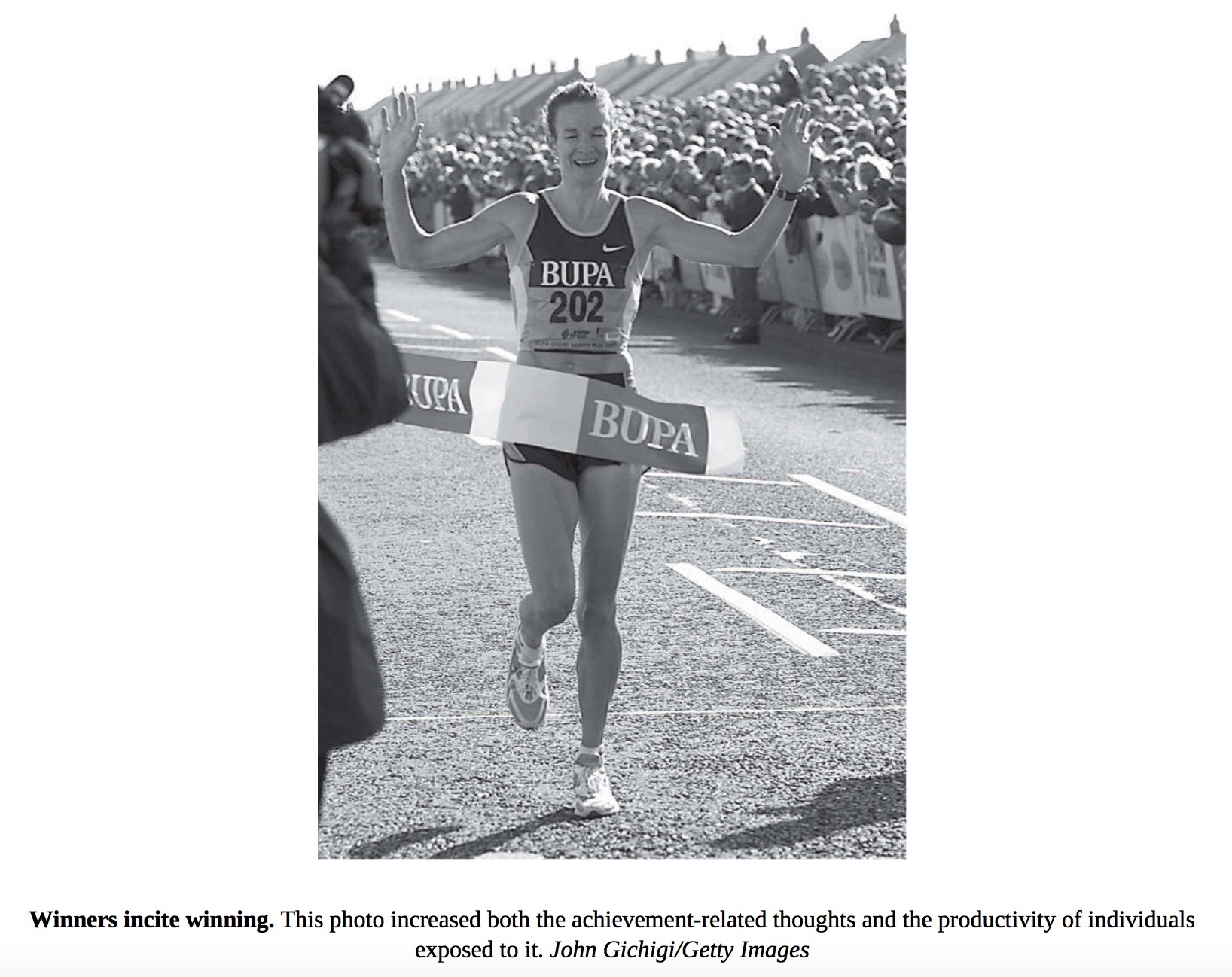
Embedding Associations
Pre-suasion is the art and science of capturing and channelling attention. The big marketing challenge in a cluttered world is capturing attention. So whilst your may know the associations that you want to use to prime your audience’s mind, you first need to capture attention. How do you do that? Pre-suasion lists 6 attention grabbing strategies
- The Sexual. Sexual stimuli have a pervasive power to command our attention, and influence our action, but the influence is more subtle and selective than we may think. For example, a recent field experiment found that only 20% of men would agree to help a woman after having been asked for directions to Martin Street, but 36.7% agreed to help after having been asked for directions to Valentine Street. The men had been primed with romantic associations, and behaved more chivalrously. On the other hand, only 8% of top advertising campaigns use sex to sell. Why? Because sex only sells when the product is linked to sexuality (cosmetics, perfume, form-fitting clothing). Sex doesn’t sell soda, soap powder or white goods because there is no strong association in the mind of the audience between sex and the product.
- The Threatening. Threats to our personal safety or the safety of those we care about has attention grabbing power. It’s arguably what attention is for – being alert to threats. Threat and fear appeals, such as in tobacco packaging, have been shown to be pre-suasively effective, when they are followed by clear instructions on how to avoid the threat. Perhaps more interesting from an advertising perspective is when the pre-suasion and persuasion are uncoupled. Research carried out by Cialdini and evolutionary psychologist Vlad Griskevicius found that the perception of threat opens us up to messages to be part of a group (where there is safety and strength in numbers). In this experiment people people responded favourably to an ad for SF Museum of Modern Art that stressed its popularity (“Visited by over a million people each year) after having seen a violent movie, but not after seeing a romantic movie. After the romantic movie, that ad that worked best emphasised distinctiveness of museum attendance (“Stand out from the crowd”). Once again, what happened before influenced how a subsequent message was received. The implication is ads and products that help people stand out will perform better when placed in or after romantic content, whilst ads and products that help people fit in will perform better in or after violent or threatening content.
- The Different. In order to survive, we need to be aware of changes to our environment – and whenever we first register a change around us, we have an ‘orienting response’ that involves diverting our attention to it. If something is distinctive, out of the ordinary is stands out, it grabs our attention. And because it grabs our attention, the importance of what makes it distinctive is amplified. This attention-grabbing capacity of the distinctive can accentuate the influence subsequent messages. For example, an experiment at NorthWestern involving a side by side online comparison of two sofas, one with comfy cushions, and the other with sturdy cushions resulted in a 58 percent to 42 percent preference for the sturdy cushion, but when two extra sofas with sturdy cushions were added to the comparison, preference for the different and distinctive sofa with comfy cushions increase to 77%. Bottom line, you don’t just have to Think Different, you have to be Different.
- The Self-Relevant. Our attention appears to be honed to information about us, or relevant to us. From the background chatter at a party, we have an uncanny knack of hearing someone mentioning our name (cocktail party effect). In personal health, a message that is self-relevant because it has been tailored to or references us is more likely to capture our attention, interest, be memorised and even acted upon. In fact, simply using the word you rather than ‘people’ may boost self-relevance
- The Unfinished. Our attention and memory shuts down once a problem is solved or an action completed. In contrast our attention remains drawn to unfinished business. The idea that people remember uncompleted or interrupted tasks better than completed tasks is known as the Zeigarnik Effect (after Blumer Zeigarnik – a student of psychologist Kurt Lewin). This explains why we remember stuff – including ads – better if they are unfinished, because our attention will remain drawn to it as we crave cognitive closure. A recent Facebook experiment shows the capacity of the unfinished to command our attention. College women viewed the Facebook profiles of four male students who had previously seen their profiles and were told whether the male students were attracted to them a lot, no more than average, or not told at all. As was predicted by ‘reciprocity principle’ (we like others who like us), the women were more attracted to the men that liked them a lot. But they were even more attracted to the men for whom they didn’t know. We may crave closure, but we can be attracted to the unfinished.
- The Mysterious. Mysteries intrigue and captivate our attention. Good writers and teachers know this, and will structure what they share as mysteries to be solved. They will begin by posing the subject as a mystery, and then deepen the mystery with surprising observations. Then, they’ll tease the audience by considering and discounting plausible but incorrect explantations, and then provide a clue to the real explanation. Only then will they resolve the mystery, and draw the implications. Whilst Cialdini does not share experimental evidence of the effectiveness of mystery at capturing, he points to his career and success has been built on systematically using it.
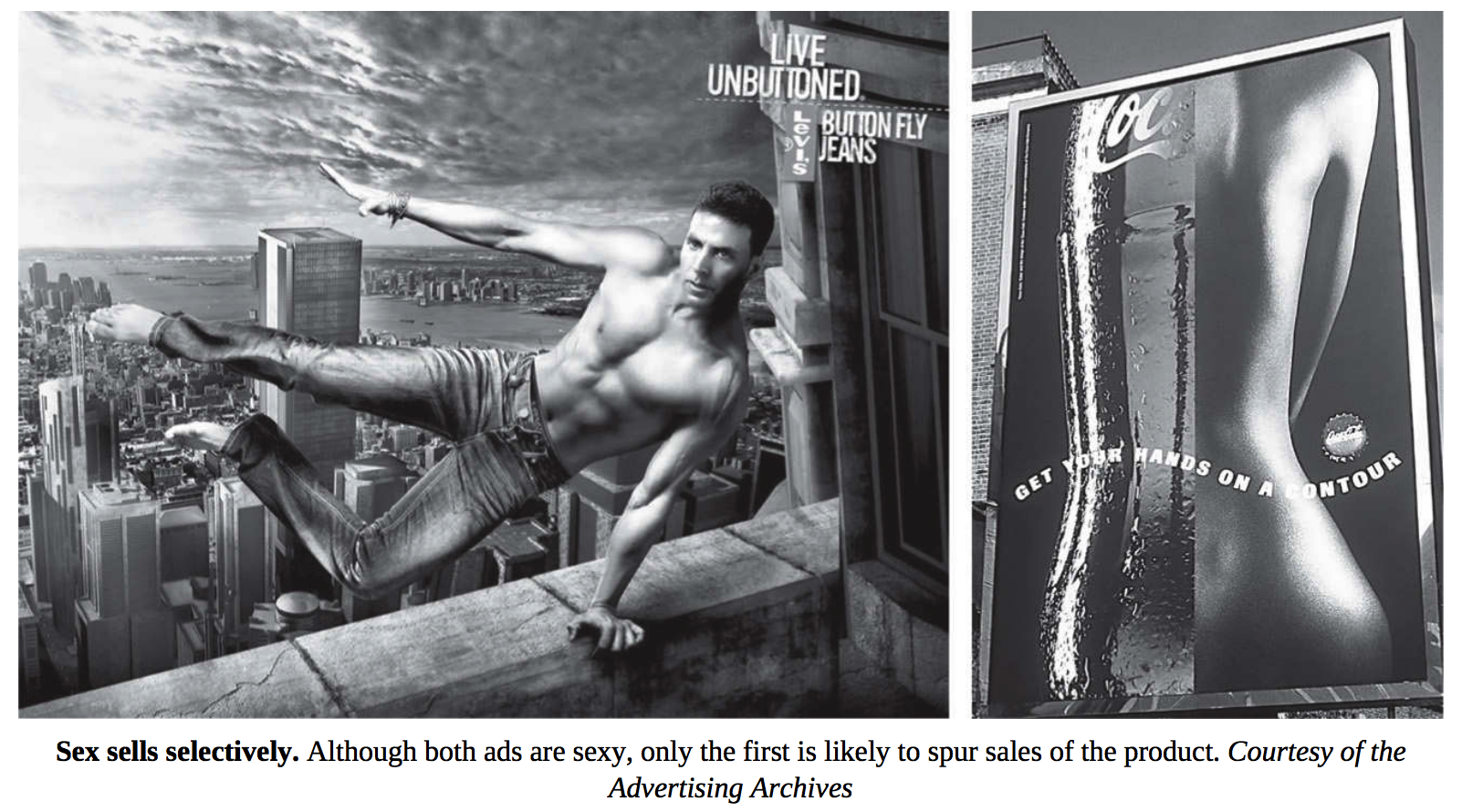
Bringing it altogether
The opportunity for marketers is to combine the embedding of associations in pre-suasive communication, with the embedding of influence cues form Cialdini’s Influence in messages. This one-two of influence – pre-suasion then persuasion – provides marketers with a powerful communications framework that moves beyond mere argument.
In doing so, the promise is that you turbo-charge your influence. Combining the two steps to influence – Cialdini provides a process for non-rational influence.
- Start with Pre-suasion. Capture and channel attention with by embedding positive category (goal) associations in attention appeals (The Sexual, The Threatening, The Different, The Self-Relevant, The Unfinished, The Mysterious)
- Then use Liking (The obligations of friendship, or of being swayed by people you like) and Reciprocity (The obligation to give back) to establish rapport and cultivate a positive association with you as a communicator – in a meaningful, unexpected, and customized manner
- Now use Authority (We follow those we view as experts) and Social Proof (The power of consensus, doing what we feel others are also doing) to reduce perceptions of uncertainty and risk
- Finally, use Consistency (Need for personal alignment) and Scarcity (We want what may not be available) to motivate action
Cialdini concludes by proposing a seventh message cue to the six originally enumerated in Influence – Unity – we say yes to ‘we’ messages that appeal to a sense shared identity (genealogy or geography) or shared activity (synchronicity, collaboration (including – co-creation)). Naturally, sitting alongside Liking and Reciprocity in step 2 in the process of influence, creating a sense of unity between communicator and audience establishes rapport and positivity.
The Brand Genetics Take
We were not only pre-suaded by Pre-suasion, we were persuaded by it too. It’s a fitting followup to the business book on Influence. As an agency, we’ll be using pre-suasion techniques to craft compelling insights and concepts, and to help brands communicate more effectively. It’s perhaps true that Pre-suasion is not quite as ‘neat’ as Influence insofar as it doesn’t offer an off-the-peg solution to influence like the six (now seven) evidence-based message cues. Pre-suasion requires knowledge of the associations people make with the category and category goals, and embedding these in pre-suasive communication that frames a subsequent message. And that requires research. But for professional communicators, Pre-suasion is a goldmine of evidence-based insight into the attentional biases that influences our behaviour, and offer practical recommendation for how to harness these biases. We unreservedly recommend Pre-suasion to all branding and marketing professionals.


